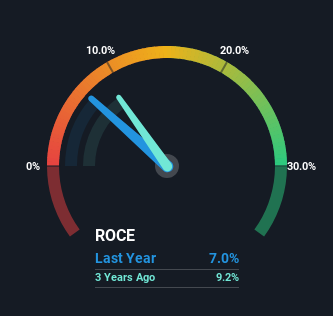- United States
- /
- Professional Services
- /
- NYSE:TRU
Returns On Capital Signal Tricky Times Ahead For TransUnion (NYSE:TRU)
There are a few key trends to look for if we want to identify the next multi-bagger. In a perfect world, we'd like to see a company investing more capital into its business and ideally the returns earned from that capital are also increasing. If you see this, it typically means it's a company with a great business model and plenty of profitable reinvestment opportunities. In light of that, when we looked at TransUnion (NYSE:TRU) and its ROCE trend, we weren't exactly thrilled.
What Is Return On Capital Employed (ROCE)?
If you haven't worked with ROCE before, it measures the 'return' (pre-tax profit) a company generates from capital employed in its business. The formula for this calculation on TransUnion is:
Return on Capital Employed = Earnings Before Interest and Tax (EBIT) ÷ (Total Assets - Current Liabilities)
0.07 = US$699m ÷ (US$11b - US$996m) (Based on the trailing twelve months to September 2024).
Thus, TransUnion has an ROCE of 7.0%. In absolute terms, that's a low return and it also under-performs the Professional Services industry average of 15%.
View our latest analysis for TransUnion

In the above chart we have measured TransUnion's prior ROCE against its prior performance, but the future is arguably more important. If you'd like to see what analysts are forecasting going forward, you should check out our free analyst report for TransUnion .
What Can We Tell From TransUnion's ROCE Trend?
On the surface, the trend of ROCE at TransUnion doesn't inspire confidence. Around five years ago the returns on capital were 9.1%, but since then they've fallen to 7.0%. However it looks like TransUnion might be reinvesting for long term growth because while capital employed has increased, the company's sales haven't changed much in the last 12 months. It may take some time before the company starts to see any change in earnings from these investments.
Our Take On TransUnion's ROCE
Bringing it all together, while we're somewhat encouraged by TransUnion's reinvestment in its own business, we're aware that returns are shrinking. Unsurprisingly then, the total return to shareholders over the last five years has been flat. On the whole, we aren't too inspired by the underlying trends and we think there may be better chances of finding a multi-bagger elsewhere.
Since virtually every company faces some risks, it's worth knowing what they are, and we've spotted 2 warning signs for TransUnion (of which 1 is a bit concerning!) that you should know about.
For those who like to invest in solid companies, check out this free list of companies with solid balance sheets and high returns on equity.
Valuation is complex, but we're here to simplify it.
Discover if TransUnion might be undervalued or overvalued with our detailed analysis, featuring fair value estimates, potential risks, dividends, insider trades, and its financial condition.
Access Free AnalysisHave feedback on this article? Concerned about the content? Get in touch with us directly. Alternatively, email editorial-team (at) simplywallst.com.
This article by Simply Wall St is general in nature. We provide commentary based on historical data and analyst forecasts only using an unbiased methodology and our articles are not intended to be financial advice. It does not constitute a recommendation to buy or sell any stock, and does not take account of your objectives, or your financial situation. We aim to bring you long-term focused analysis driven by fundamental data. Note that our analysis may not factor in the latest price-sensitive company announcements or qualitative material. Simply Wall St has no position in any stocks mentioned.
About NYSE:TRU
TransUnion
Operates as a global consumer credit reporting agency that provides risk and information solutions.
Fair value with moderate growth potential.
Similar Companies
Market Insights
Community Narratives




